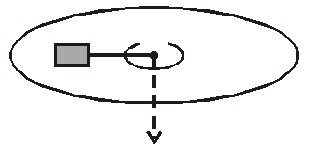Q.
A block of mass $0.1 \, kg$ is attached to a cord passing through a hole in a horizontal frictionless horizontal surface as shown in the figure. The block is originally revolving at a distance of $0.4 \, m$ from the hole, with an angular velocity of $2 \, rad \, s^{- 1}$ . The cord is then pulled from below, shortening the radius of the circle in which the block revolves to $0.2 \, m$ . Considering the block to be point mass, calculate the new angular velocity (in $rad \, s^{- 1}$ ).

NTA AbhyasNTA Abhyas 2020System of Particles and Rotational Motion
Solution: